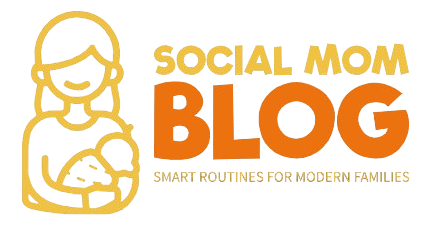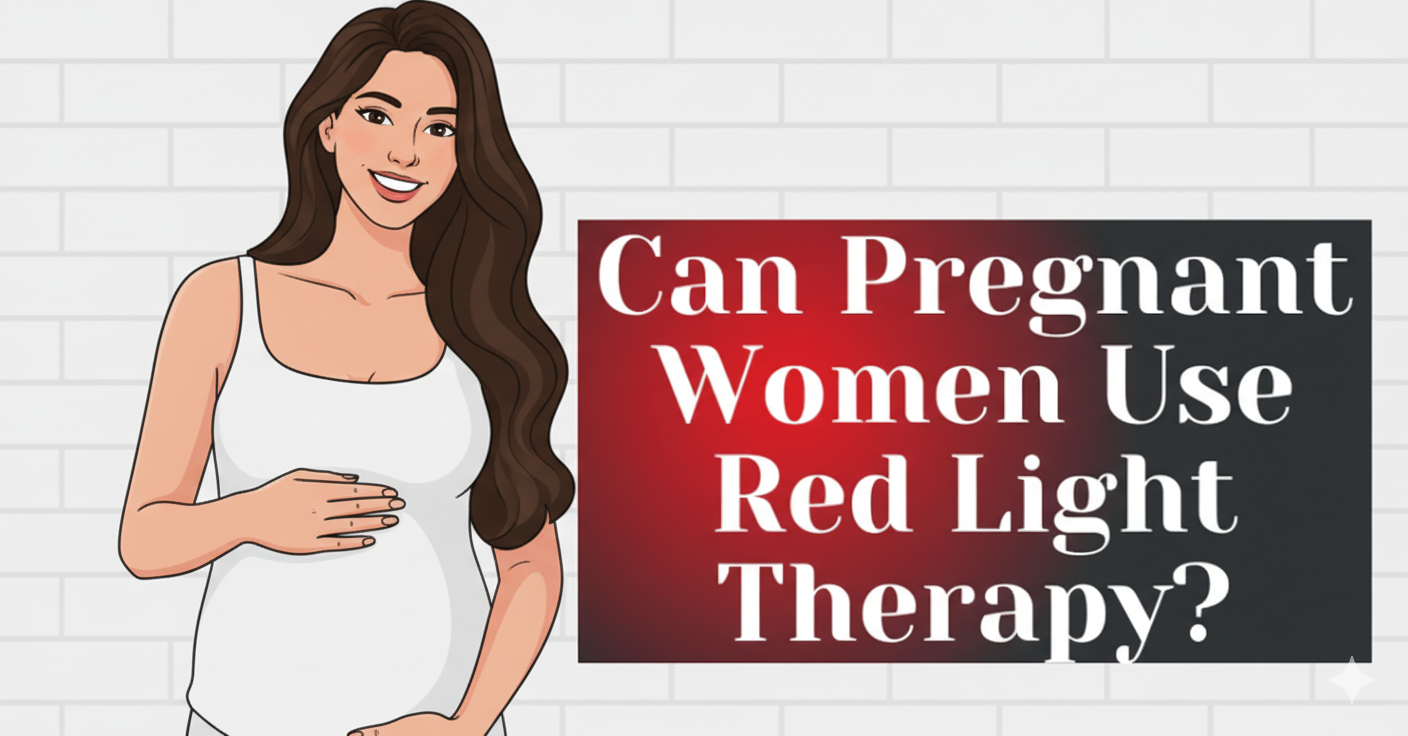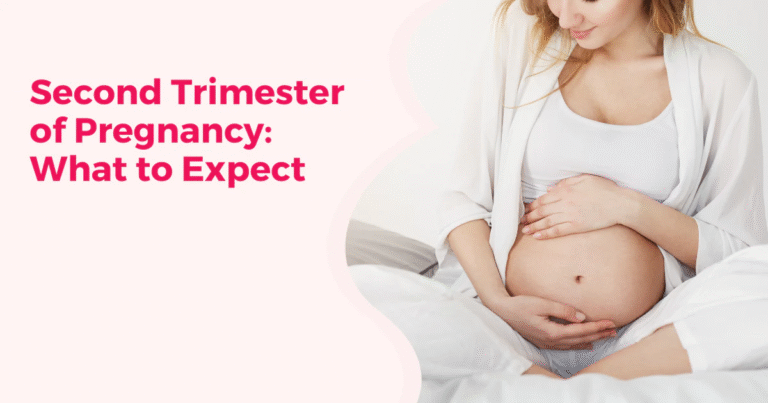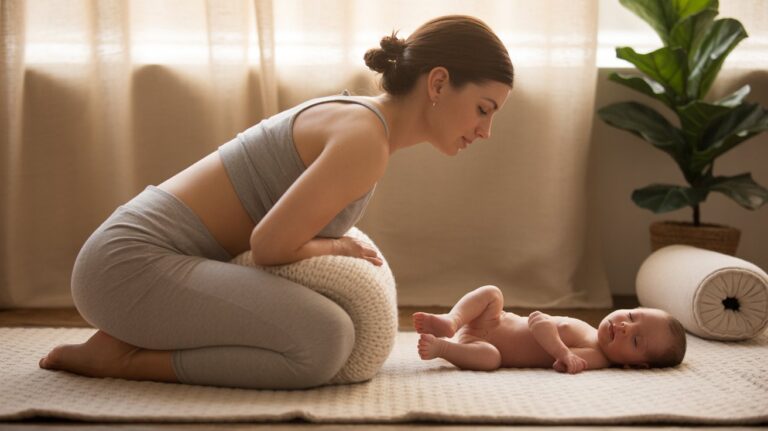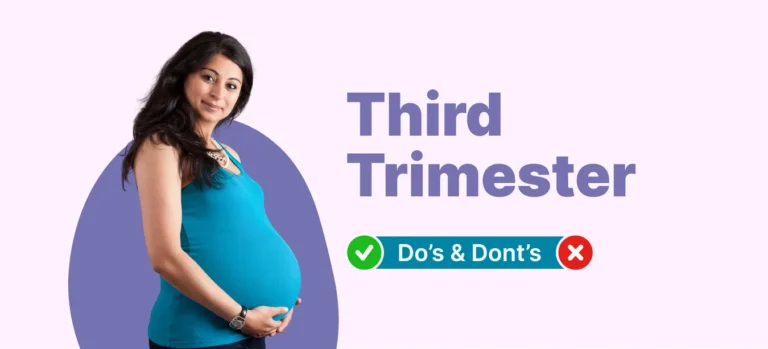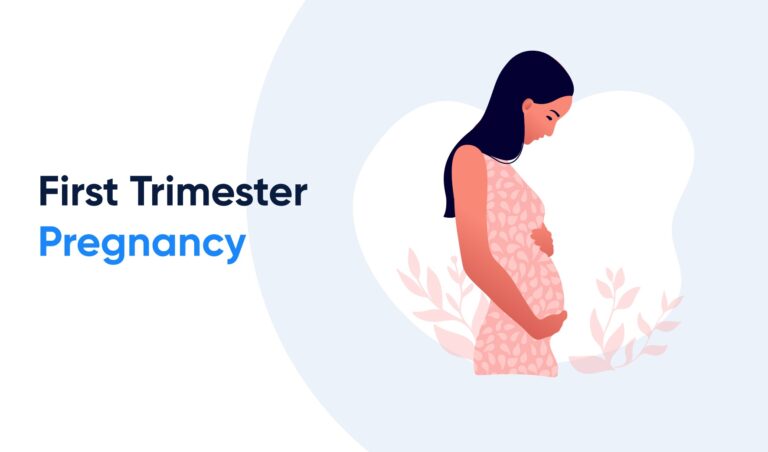Red Light Therapy Pregnancy Guide: Safety & Risks Explained
Red light therapy is a popular wellness treatment known for boosting skin health, reducing pain, and supporting recovery, but what about red light therapy pregnancy? Many expectant mothers wonder if using red light therapy while pregnant is safe, especially when searching for drug-free ways to ease aches, skin changes, or fatigue.
While some studies suggest potential benefits, research on pregnancy-specific safety remains limited, leaving experts cautious. This guide explores what red light therapy is, possible benefits and risks of red light therapy during pregnancy, is red light therapy safe for pregnancy, and what doctors recommend. Always consult your OB-GYN before starting any treatment while pregnant.
What Is Red Light Therapy?
Red light therapy, sometimes called photobiomodulation or low-level laser therapy (LLLT), is a non-invasive treatment that uses specific wavelengths of red and near-infrared (NIR) light to stimulate healing and repair within the body. According to the American Academy of Dermatology (AAD), it has been widely used to improve skin health, reduce inflammation, and support tissue recovery without exposing the skin to harmful ultraviolet (UV) rays.
The science behind red light therapy centers on the mitochondria, often referred to as the powerhouse of the cell. When exposed to red light in the 630–660 nanometer range or near-infrared light in the 800–850 nanometer range, mitochondria absorb the light and increase the production of adenosine triphosphate (ATP). This extra cellular energy helps repair damaged tissues, improves circulation through nitric oxide release, and stimulates collagen production for stronger, healthier skin.
There are different ways to use red light therapy. Professional treatments are available at dermatology clinics or medical offices where stronger devices may be used under supervision. At home, people often use LED masks, handheld wands, wall-mounted panels, or even full-body red light beds. While home devices are less powerful than clinical equipment, they can still provide benefits when used consistently and safely.
The U.S. Food and Drug Administration (FDA) has cleared certain red light therapy devices for general wellness and skin applications. However, this clearance does not specifically address pregnancy, which is why expert guidance and medical consultation are strongly recommended before use in expectant mothers.
Is Red Light Therapy Safe During Pregnancy? What Experts Say
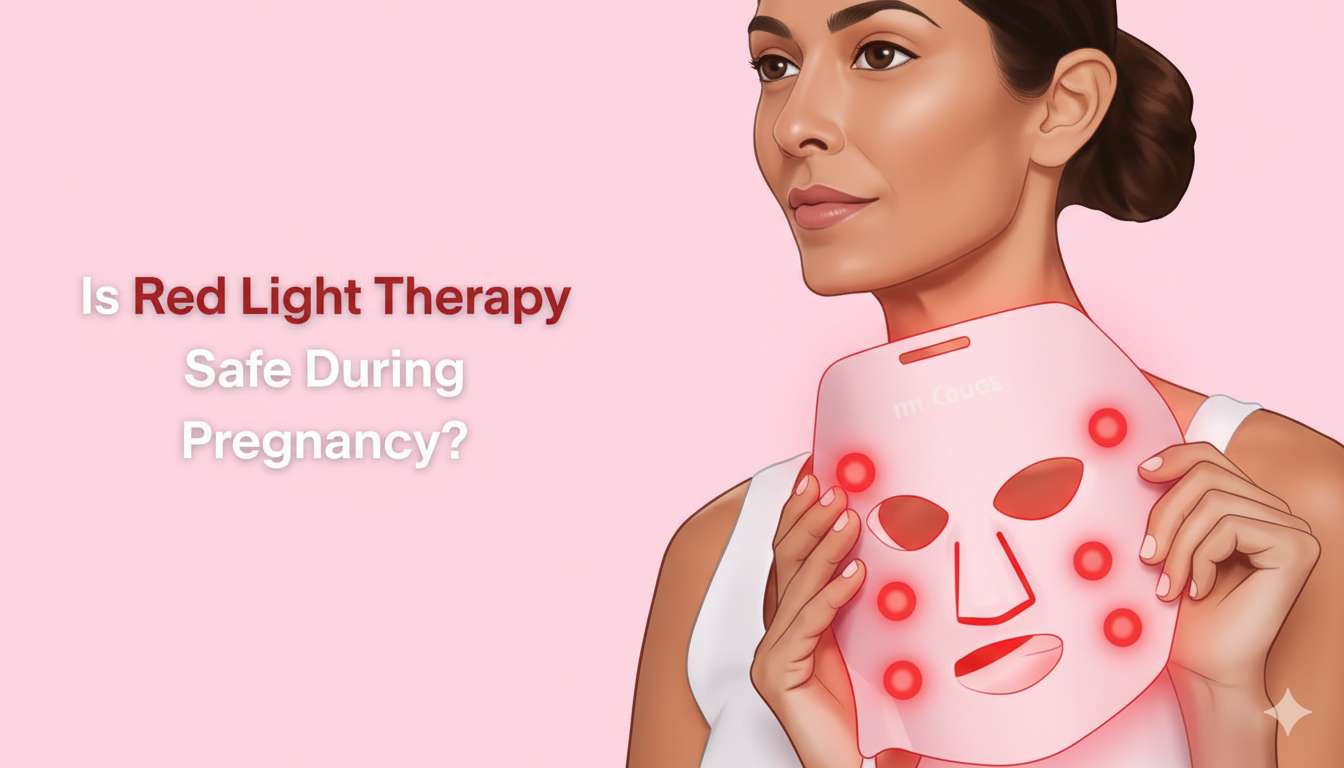
One of the most common questions expectant mothers ask is, “Is red light therapy safe for pregnancy?” While red light therapy has gained popularity for skin health, pain relief, and recovery, its safety during pregnancy remains uncertain.
The available studies are limited, often small in scale, and typically conducted on non-pregnant adults. This lack of targeted research means that medical experts and professional boards recommend approaching the therapy with caution.
The American College of Obstetricians and Gynecologists (ACOG) does not currently provide official guidance on red light therapy in pregnancy, largely because there is not enough data. The U.S. Food and Drug Administration (FDA) has cleared some devices for general wellness and dermatological use, but this clearance does not specifically extend to pregnant populations. Similarly, dermatology boards acknowledge the potential benefits of photobiomodulation but stop short of calling it safe for use during pregnancy.
Most physicians and dermatologists agree on a few key points. First, red light therapy is considered non-invasive and unlikely to cause harm when used on localized areas such as the face or limbs. However, they strongly advise against direct use on the abdomen or lower back. The concern is not based on proven harm, but rather on the unknown effects of stimulating cell activity near a developing fetus.
In short, while red light therapy in pregnancy does not appear to carry clear evidence of danger, the lack of robust clinical trials means it cannot yet be considered universally safe. For this reason, health professionals emphasize one message above all: always consult with your obstetrician before beginning any new therapy during pregnancy.
Red Light Therapy During Pregnancy: Safety Guide
Safety in the First Trimester
When it comes to red light therapy during pregnancy first trimester, experts agree this is the stage to be most cautious. The first 12 weeks involve rapid organ development and the establishment of the placenta, making it the most sensitive period of pregnancy.
While no studies have proven harm from red light therapy, the possibility that increased cellular activity could influence fetal development cannot be ruled out. For this reason, most obstetricians and dermatologists recommend avoiding red light therapy during the first trimester unless there is a clear medical necessity and it is performed under professional supervision.
Safety in the Second Trimester
The second trimester is often described as the safest period of pregnancy for general wellness activities. For women considering red light therapy during pregnancy second trimester, the theoretical risks appear lower than in the early weeks.
Some people look to red light therapy at this stage for skin-related changes, such as acne or pigmentation, or to support mood and energy. Even so, there is still no high-quality research proving safety, so any use should be limited, localized to non-abdominal areas, and discussed with a healthcare provider before starting.
Safety in the Third Trimester
By the third trimester, the baby is mostly developed, and the mother may experience more physical discomfort such as back pain, swelling, or fatigue. This leads some to explore red light therapy during pregnancy third trimester as a non-drug option for relief.
While theoretical benefits exist, the same rule applies: avoid direct exposure to the abdomen and lower back, since there is no evidence confirming safety in these areas. Using red light therapy on the face or limbs for skin, mood, or circulation may be more acceptable when cleared by a medical professional.
Safe vs Unsafe Body Zones
One of the most important considerations is where red light therapy is applied. Using a red light therapy face mask during pregnancy is generally considered safer since the light remains localized to the skin surface. Applying light to the arms or legs may also carry little risk.
However, applying red light directly to the belly during pregnancy or to the lower back should be avoided, as the effects on the fetus are unknown. Regardless of the treatment area, protective goggles should always be worn to prevent eye damage, especially when using strong panels or clinical-grade devices.
Benefits of Red Light Therapy for Prenatal Wellness
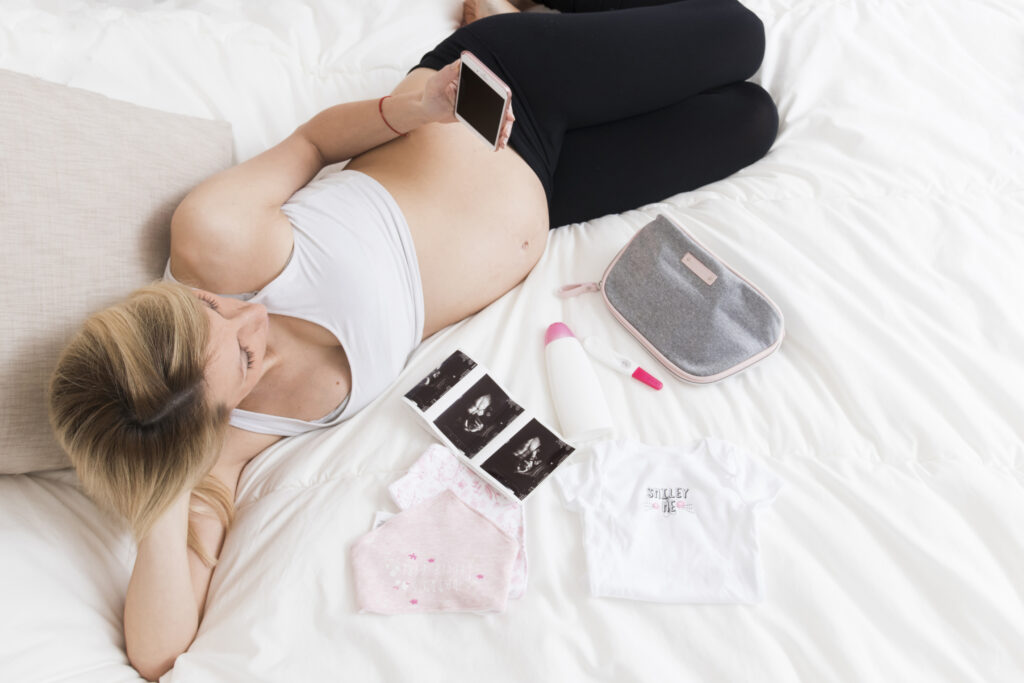
Pregnancy can bring physical changes, hormonal shifts, and new sources of discomfort. While safety is still under review, many women are interested in the potential benefits of red light therapy during pregnancy as a gentle, non-drug approach to wellness.
Supporters believe that when used with caution, red light therapy may improve circulation, reduce inflammation, and stimulate collagen production. These effects could help with common pregnancy concerns such as pain, fatigue, skin changes, and sleep disturbances.
Pain and Discomfort Relief
One of the most common reasons women explore red light therapy for pain relief during pregnancy is to manage persistent discomfort without relying on medication. Back pain, pelvic pressure, and hip soreness are frequent complaints as pregnancy progresses.
Red light therapy has been shown in other populations to boost mitochondrial activity, which increases adenosine triphosphate (ATP) production. This additional cellular energy supports tissue repair and enhances blood flow through the release of nitric oxide. Improved circulation can reduce inflammation and provide relief from aches, which is why some consider it a safe alternative for pregnancy back pain relief when applied away from the abdomen.
Mood, Energy and Fatigue
Fluctuating hormones and increased metabolic demands can leave expectant mothers feeling drained. Interest in red light therapy mood pregnancy use comes from its ability to influence serotonin levels and improve energy metabolism. By improving circulation and oxygen delivery to tissues, red light therapy may reduce feelings of fatigue and support emotional balance.
Some small studies have compared red light therapy with bright light therapy for depression, suggesting potential overlap in benefits. While larger trials are needed, these findings help explain why some women consider red light therapy for mood support and better overall energy during pregnancy.
Skin Health: Acne, Melasma and Stretch Marks
Skin changes are another area where expectant mothers seek help. Acne flare-ups, pigmentation changes such as melasma, and stretch marks are common concerns. Red light therapy pregnancy acne interest stems from its anti-inflammatory effect, which may calm breakouts without harsh topical treatments. For red light therapy pregnancy melasma, the evidence is less clear, but some users report reduced pigmentation when light therapy is applied consistently.
Stretch marks remain a top concern during pregnancy, and because red light therapy stimulates collagen production and tissue repair, it may support skin strength and elasticity, potentially reducing their appearance. These benefits fall under the broader category of skin rejuvenation associated with red light therapy.
Better Sleep Support
Quality sleep often becomes harder to achieve during pregnancy. Interest in red light therapy sleep pregnancy use is based on its potential to regulate melatonin and support a healthy circadian rhythm.
Exposure to red light in the evening may signal the body to prepare for rest, helping expectant mothers fall asleep more easily and improve sleep quality. This makes red light therapy appealing to those seeking a natural way to reduce insomnia or nighttime restlessness without medication.
How Red Light Therapy Supports Hormonal Balance During Pregnancy
Pregnancy places an enormous metabolic load on the body, often compared to the demands faced by endurance athletes. Dietitian Natalie Mokari notes that women need hundreds of additional calories daily as the pregnancy advances, highlighting how energy production becomes a constant challenge.
Interest in red light therapy hormonal balance pregnancy use comes from its effect on mitochondria, the energy factories of cells. By improving mitochondrial efficiency and increasing ATP production, red light therapy may help the body manage fatigue more effectively. These same mechanisms could play a role in stabilizing mood swings and supporting overall hormonal balance, although direct pregnancy-specific studies remain limited.
Possible Risks of Red Light Therapy During Pregnancy
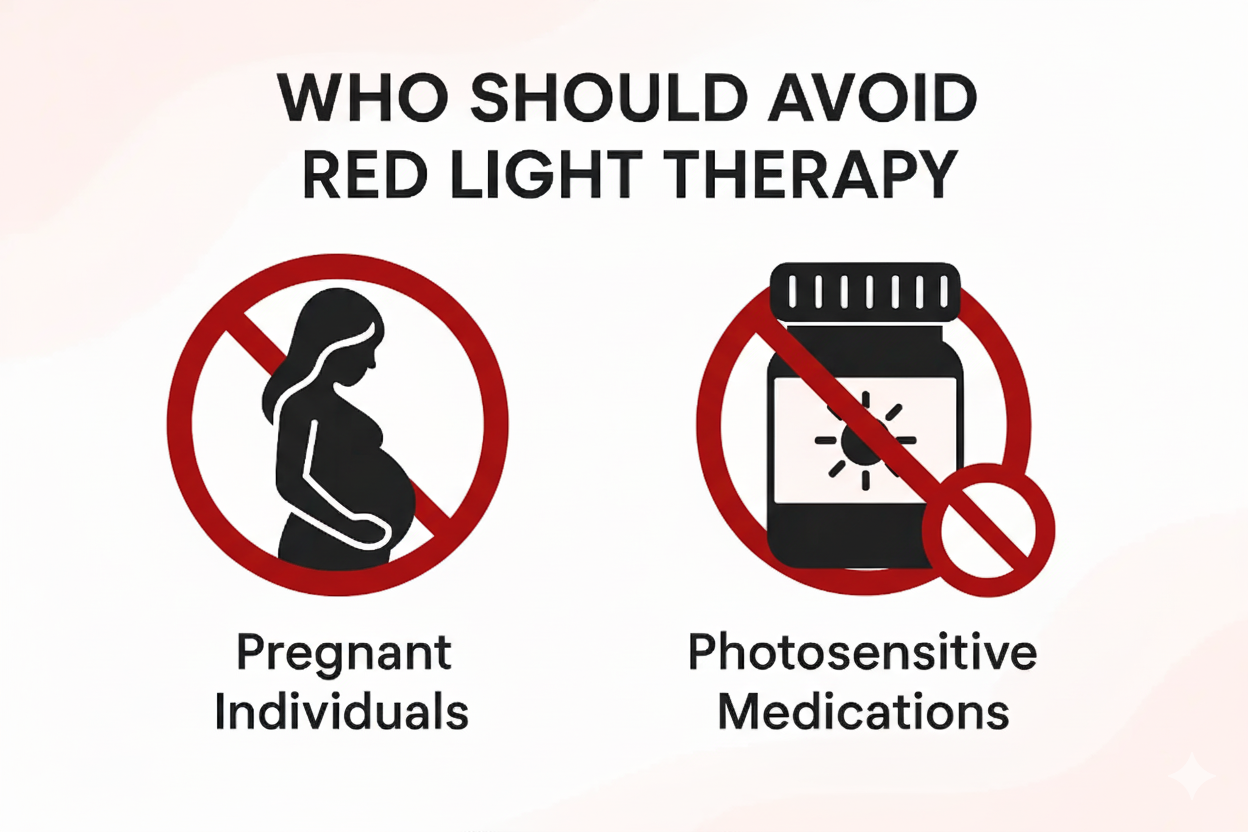
The biggest concern with red light therapy dangers pregnancy is that doctors don’t fully know how it would impact you and your baby. But experts point to other potential downsides to consider, too.
Red light therapy is designed to create a mild inflammatory response in your skin to stimulate healing and collagen formation. “The challenge is that the skin takes a hormonal beating during pregnancy,” one dermatologist explains. “Introducing a treatment that triggers more inflammation when the skin is already stressed might make that inflammation more pronounced.”
There’s also a potential risk that high-intensity beams could impact the developing fetus if they’re aimed directly at your abdomen, a medical advisor notes.
Of course, when discussing red light therapy dangers, it’s clear the risks exist both inside and outside of pregnancy. A common question is, can you overdo red light therapy? The answer is yes, and the consequences include burns and significant skin redness. “Red light therapy could cause burns, skin irritation, and possibly an allergic reaction,” the advisor says. “Also, it can cause eye damage; protective goggles should always be used.”
This highlights exactly who should not use red light therapy, including those on photosensitive medications or with a history of skin cancer, as the risks are heightened for them.
Red Light Therapy After Pregnancy (Postpartum & Breastfeeding)
Once your baby is out and about, the “rules” on red light therapy change a lot, and the potential benefits really ramp up for recovery. It’s safe to say there is strong interest in using RLT during this time, and generally, it’s considered much safer than during pregnancy.
Red Light Therapy for Postpartum Recovery
The time after delivery is all about healing, and this is where red light therapy postpartum can really shine. Its cell-stimulating power is perfect for a body that’s just gone through a marathon.
| Category | How RLT Helps (The Entities) | Key Benefits |
|---|---|---|
| Physical Recovery | C-section healing & episiotomy recovery. | RLT speeds up postpartum wound healing by reducing inflammation and getting those cells moving. The sooner you use it, the better. |
| Skin & Scars | Reducing scar tissue and stretch marks. | It can help soften and flatten C-section healing scars, lessening their appearance. The collagen boost helps skin elasticity get back on track. |
| Mental & Emotional | Improving mood and balancing hormones. | Studies show light therapy may help with Postpartum depression symptoms and general mood regulation. It can help balance hormones and improve energy—a major win when you’re sleep-deprived! |
| Discomfort | Aches, pains, and the postpartum belly area. | RLT can target muscle soreness and pain in the hips and joints. It supports healing in the abdominal area, though it won’t magically shrink the postpartum belly on its own! |
Red Light Therapy Breastfeeding Safety
This is a common question, and the good news is that red light therapy breastfeeding safe is the general consensus, but you still need to be sensible.
- Consult Provider: Even though it’s generally considered safe, it’s still best practice to consult your provider or a lactation expert before starting, especially if you plan to apply it directly to your breasts.
- Is it Safe? Most doctors and lactation consultants agree it’s safer during this time because the light does not affect the composition of breast milk or enter your bloodstream to be passed to the baby.
- Healing Soreness: Some evidence suggests RLT can help with sore or cracked nipples and reduce inflammation from engorgement.
Alternatives to Red Light Therapy During Pregnancy
Since red light therapy is a bit of a gray area for many doctors, it’s super helpful to know about safe spa treatments pregnancy and at-home alternatives that can give you similar perks without the “is it safe?” stress. You don’t have to just tough it out!
For those thinking about how to get that post-baby body back down the line, here’s what you need to know about liposuction after pregnancy. Here are some great substitutes for common pregnancy issues:
| Concern RLT Might Address | A Safer Alternative | The Scoop |
|---|---|---|
| Aches & Pains | Prenatal yoga and massage. | Safe spa treatments pregnancy often include prenatal massage, which is a game-changer for back pain and swelling. Gentle prenatal yoga can keep your body moving and flexible. Just make sure the massage therapist knows you’re expecting! |
| Skin Issues (Acne, dullness) | Safe topical treatments and masks. | Skip the retinol and harsh acids, and talk to your OB-GYN or dermatologist about pregnancy-safe skincare ingredients. Think gentle cleansers and moisturizers. |
| Mood & Energy | Bright light therapy and meditation. | If you’re struggling with mood or fatigue, studies show bright light therapy can be a big help (it’s different from red light). Daily meditation or even just taking a few minutes to chill can help you feel more grounded. |
| Relaxation & Sleep | Warm (not hot!) baths, gentle exercise. | Stay away from any spa treatments that aren’t safe during pregnancy because they raise your core body temperature (like saunas or hot tubs). Instead, try a warm bath or approved mild exercise like swimming to help you wind down and sleep better. |
Knowing about these easy swaps means you can still focus on wellness and comfort throughout your pregnancy journey, worry-free!
Conclusion
Red light therapy pregnancy care offers a gentle, non-invasive way to ease common discomforts like swelling, muscle tension, and mood fluctuations. When used safely and consistently, red light therapy during pregnancy can support overall wellness, promoting relaxation and skin health without harsh interventions.
At-home red light therapy devices can be safely used by expectant mothers, focusing on comfort, safety, and effectiveness. Red light therapy pregnancy treatments provide a natural, non-invasive way to ease discomfort and support overall wellness from home. Incorporating red light therapy during pregnancy into your daily routine can promote relaxation, improve skin health, and enhance overall well-being throughout this special time.
FAQs
Is red light therapy safe for pregnancy?
Due to a lack of conclusive research on fetal impacts, red light therapy is not recommended during pregnancy. The safest approach is to avoid it, especially on the abdomen and lower back, unless explicitly approved by your doctor.
Can you use red light therapy while pregnant?
It is not advised. Experts caution that the effects on a developing fetus are unknown, and hormonal changes can make pregnancy skin more sensitive to potential inflammatory responses from the treatment.
Is red light therapy safe during all trimesters of pregnancy?
No. The precaution applies to all trimesters, as fetal development is ongoing. There is no trimester where red light therapy has been proven safe for direct abdominal application.
Can I use a red light face mask or wand while pregnant?
Using devices on the face carries a lower theoretical risk than on the torso, but it is still not recommended without medical guidance. Pregnancy can increase skin sensitivity, raising the risk of irritation.
Can I use red light therapy for pain relief during pregnancy?
Safer, proven alternatives for pregnancy pain relief (like prenatal massage or physical therapy) exist. Due to the unknown risks of RLT on the fetus, it should not be used for this purpose.
Could RLT help with pregnancy acne?
While RLT can treat acne, its use for pregnancy acne is not recommended. Hormonal fluctuations are the primary cause, and many standard acne treatments are preferred and vetted for use during pregnancy.
Could RLT help with pregnancy melasma?
RLT may improve skin tone, but its specific effect on pregnancy-induced melasma is unproven. Since melasma often resolves postpartum, introducing an unknown variable like RLT is an unnecessary risk.
Are there any benefits to using red light therapy after giving birth?
Yes. Postpartum, RLT can be beneficial for healing perineal tears or C-section scars, reducing inflammation, and aiding in muscle recovery, once cleared by a doctor.
Can red light therapy help shrink a postpartum belly faster?
It may offer minor support by reducing inflammation and potentially aiding skin elasticity. However, it is not a substitute for core rehabilitation and a healthy diet, which are the primary drivers of postpartum recovery.
Can you use red light therapy while breastfeeding?
There is no known risk to milk supply or the infant from topical use on areas like the face or joints. However, avoid direct application to the breasts and nipples. Always consult your doctor first.
How many red light therapy treatments do you need?
Results vary by goal, but most conditions require consistent treatment. You typically need 3-5 sessions per week for several weeks to see initial benefits, with ongoing sessions for maintenance.
How much weight can you lose with red light therapy?
Red light therapy is not a primary weight loss tool. It may assist by reducing inflammation and aiding spot measurement loss (inches), but it does not cause significant fat loss without diet and exercise.
What spa treatments aren’t safe during pregnancy?
Avoid treatments with high heat (saunas, hot tubs), high-pressure techniques, and chemicals that can be absorbed. This includes body wraps, electrolysis, and treatments using essential oils like rosemary or sage.
When should you avoid red light therapy?
Avoid RLT if you are pregnant, on photosensitizing medications, have a history of skin cancer, or have a condition that causes light sensitivity. Always protect your eyes with goggles.
Who should not use red light therapy?
The main groups who should not use it are: pregnant individuals, people taking certain antibiotics or acne medications, those with a personal history of skin cancer, and anyone with photosensitive disorders like lupus.
